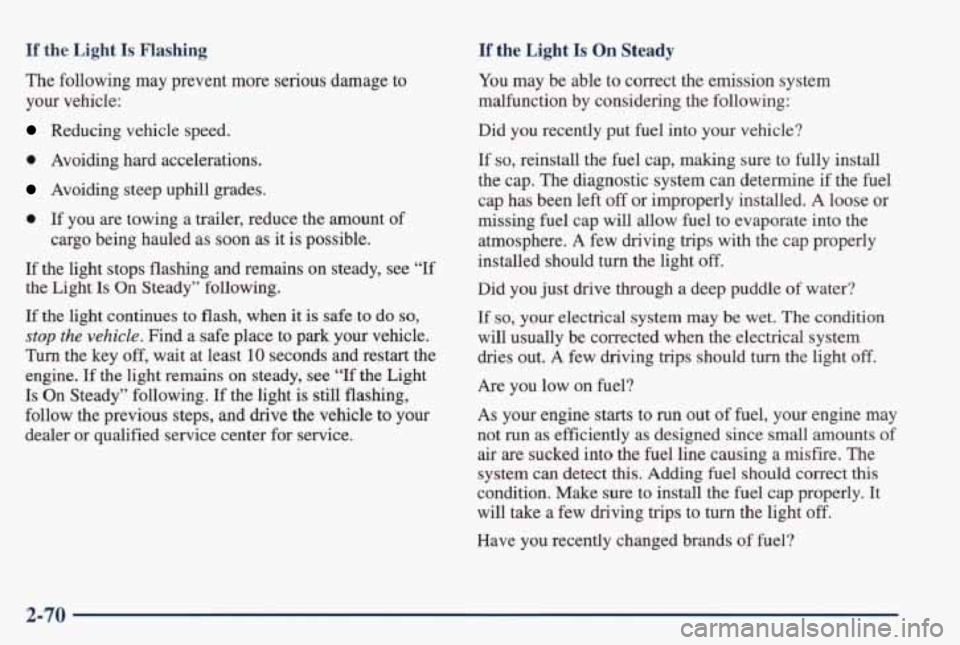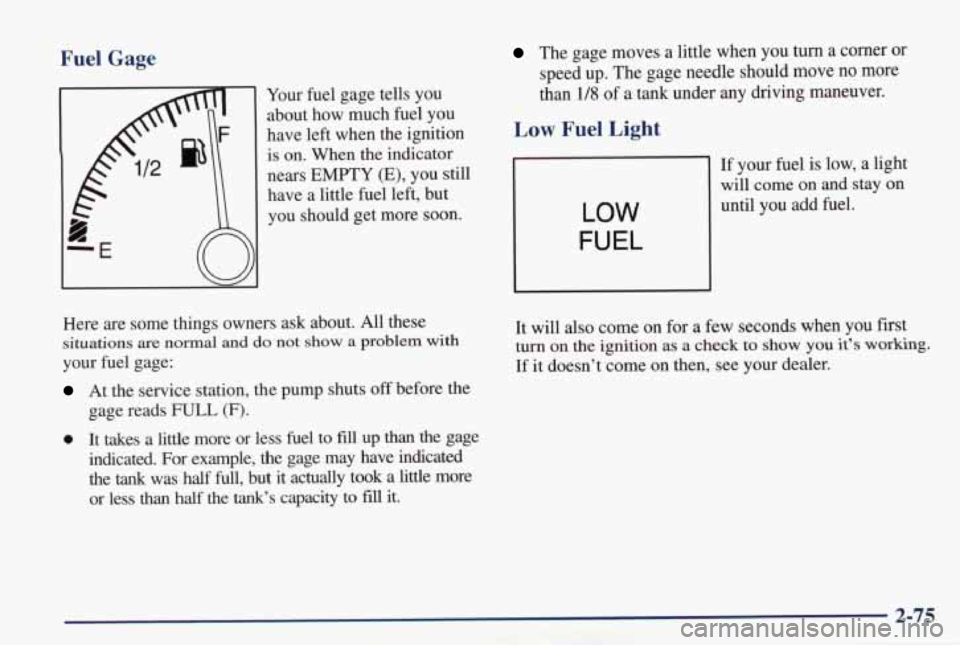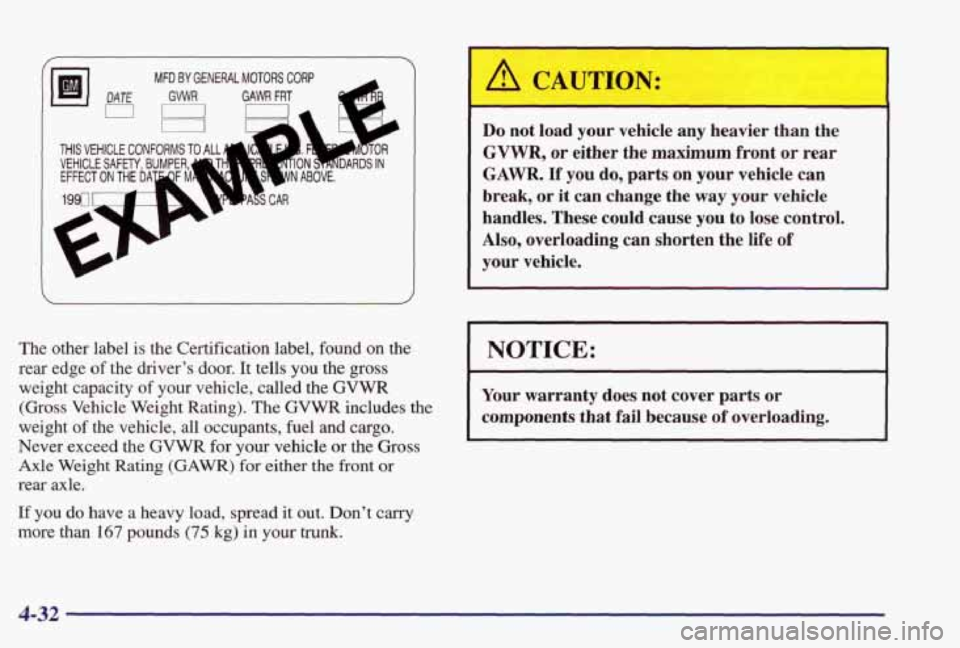1998 PONTIAC GRAND PRIX fuel cap
[x] Cancel search: fuel capPage 145 of 402

If the Light Is Flashing If the Light Is On Steady
The following may prevent more serious damage to
your vehicle:
Reducing vehicle speed.
0 Avoiding hard accelerations.
Avoiding steep uphill grades.
0 If you are towing a trailer, reduce the amount of
cargo being hauled as soon as it is possible.
If the light stops flashing and remains on steady, see “If
the Light
Is On Steady” following.
If the light continues to flash, when
it is safe to do so,
stop the vehicle. Find a safe place to park your vehicle.
Turn the key
off, wait at least 10 seconds and restart the
engine. If the light remains on steady, see “If
the Light
Is On Steady” following. If the light is still flashing,
follow the previous steps, and drive the vehicle to your dealer or qualified service center for service.
You may be able to correct the emission system
malfunction by considering the following:
Did you recently put
fuel into your vehicle?
If
so, reinstall the fuel cap, making sure to fully install
the cap. The diagnostic system
can determine if the fuel
cap has been left off or improperly installed. A loose or
missing fuel cap will allow fuel to evaporate into the
atmosphere.
A few driving trips with the cap properly
installed should
turn the light off.
Did you just drive through a deep puddle of water?
If so, your electrical system may be wet. The condition
will usually be corrected when the electrical system
dries out.
A few driving trips should turn the light off.
Are you low on fuel?
As your engine starts to run out of fuel, your engine may
not
run as efficiently as designed since small amounts of
air are sucked into the fuel line causing a misfire. The
system can detect
this. Adding fuel should correct this
condition. Make sure to install the fuel cap properly. It
will take a few driving trips to turn the light off.
Have you recently changed brands of fuel?
2-70
Page 150 of 402

Fuel Gage
Your fuel gage tells you
about how much fuel you
have left when the ignition
is on. When the indicator
nears
EMPTY (E), you still
have a little fuel left, but
you should get more soon.
Here are some things owners ask about. All these
situations are normal and do not show a problem with
your fuel gage:
At the service station, the pump shuts off before the
gage reads
FULL (F).
0 It takes a little more or less fuel to fill up than the gage
indicated. For example, the gage may have indicated
the
tank was half full, but it actually took a little more
or less than
half the tank‘s capacity to fill it.
The gage moves a little when you turn a comer or
speed up. The gage needle should move no more
than 1/8 of a tank under any driving maneuver.
Low Fuel Light
If your fuel is low, a light
will come on and
stay on
until you add fuel.
LOW
FUEL
It will also come on for a few seconds when you first
turn on the ignition as a check to show you it’s working.
If it doesn’t come on then, see your dealer.
2-75
Page 224 of 402

Run your engine only as long as you must. This saves
fuel. When you run the engine, make it
go a little faster
than just idle. That is, push the accelerator slightly. This
uses less fuel for the heat that you get and it keeps the
battery charged. You will need
a well-charged battery to
restart the vehicle, and possibly for signaling later on
with your headlamps. Let the heater
run for a while.
Then, shut the engine off and close the window almost
all the way to preserve the heat. Start the engine again
and repeat this only when you feel really uncomfortable
from the cold. But do it as little as possible. Preserve the
fuel as long as you can.
To help keep warm, you can get
out
of the vehicle and do some fairly vigorous exercises
every half hour or
so until help comes.
Loading Your Vehicle
TIRE - LOADING INFORMATION A
OCCUPANTS
MAX. LOADING @ GVWR SAME
1 1
r
'U
IT, ADD 28KPA (4LBS)
Manual for tire pressure needed at
himlH(100 mph) or higher speeds, where legal, kr nrlrlitinnal tira inlnrmo+inn
Two labels on your vehicle show how much weight it
may properly carry. The Tire-Loading Information label
is on the inside of the trunk lid. The label tells you the
proper size, speed rating and recommended inflation pressures for the tires on your vehicle. It also gives you
important information about the number
of people that
can be in your vehicle and the total weight you can
carry. This weight is called the vehicle capacity weight
and includes the weight
of all occupants, cargo and all
nonfactory-installed options.
4-3 1
Page 225 of 402

MFD BY GENERAL MOTORS CORP
GVWR GAWR FRT -- I 4r I
THIS VEHICLE CONFORMS TO ALL
The other label is the Certification label, found on the
rear edge of the driver’s
door. It tells you the gross
weight capacity of your vehicle, called the
GVWR
(Gross Vehicle Weight Rating). The GVWR includes the
weight of the vehicle, all occupants, fuel and cargo.
Never exceed the GVWR for your vehicle
or the Gross
Axle Weight Rating (GAWR) for either the front or
rear
axle.
If you do have a heavy load, spread it out. Don’t carry
more than 167 pounds (75 kg) in your trunk.
Do not load your vehicle any heavier than the
GVWR, or either the maximum front or rear
GAWR. If you do, parts on your vehicle can
break, or it can change the way your vehicle
handles. These could cause
you to lose control.
Also, overloading can shorten the life of
your vehicle.
I NOTICE: I
Your warranty does not cover parts or
components that fail because
of overloading.
4-32
Page 276 of 402

Section 6 Service and Appearance Care
Here you will find information about the care of your vehicle. This section begins with service and fuel informa\
tion,
and then it shows how to check important fluid and lubricant \
levels. There
is also technical information about your
vehicle, and
a part devoted to its appearance care.
6-2
6-3
6-5
6-6
6-8
6-8
6-
13
6-20
6-22
6-26
6-32
6-33
6-36
6-37
6-44 Service
Fuel
Fuels in Foreign Countries
Filling Your Tank
Filling a Portable Fuel Container Checking Things Under the Hood
Engine Oil Air Cleaner
Automatic Transaxle Fluid
.
Engine Coolant
Windshield Washer Fluid
Brakes
Battery
Bulb Replacement
Windshield Wiper Blade Replacement 6-44
6-52
6-53 6-55
6-56
6-57
6-59
6-60
6-6 1
6-6
1
6-62
6-68
6-70
6-70 Tires
Appearance Care
Cleaning the Inside of
Your Vehicle
Care
of the Safety Belts and Built-in Child
Restraint Harness Cleaning the Outside
of Your Vehicle
Cleaning Aluminum Wheels
(If Equipped)
Underbody Maintenance
Appearance Care Materials Chart
Vehicle Identification Number (VIN)
Service
Parts Identification Label
Electrical System
Capacities and Specifications Normal Maintenance Replacement
Parts
Air Conditioning Refrigerants
Page 281 of 402

Filling Your Tank The cap is behind the fuel door on the left side of
your vehicle.
1 A CAUTION:
Gasoline vapor is highly flammable. It burns
violently, and that can cause very bad injuries.
Don’t
smoke if you’re near gasoline or refueling
your vehicle. Keep sparks, flames and
smoking
materials away from gasoline.
While refueling, hang the cap by the tether from the pin
on the fuel door.
To remove the cap, turn it slowly to the left
(counterclockwise). The cap
has a spring in it; if you let
go of the cap too soon, it will spring back to the right.
6-6
Page 282 of 402

A CAUTION: I
If you get gasoline on yourself and then
something ignites it, you could be badly burned.
Gasoline can spray out on you if you open the
fuel filler cap too quickly. This spray can happen
if your tank
is nearly full, and is more likely in
hot weather. Open the fuel filler cap slowly and
wait for any ‘‘hiss” noise to stop. Then unscrew
the cap
all the way.
Be careful not to spill gasoline. Clean gasoline from
painted surfaces as soon as possible. See “Cleaning the
Outside of Your Vehicle” in the Index. When you put the cap back on, turn
it clockwise until
you hear a clicking sound. Make sure you fully install
the cap. The diagnostic system can determine if the fuel
cap has been left
off or improperly installed. This would
allow fuel
to evaporate into the atmosphere. See
“Malfunction Indicator
Lamp” in the Index.
.
NOTICE:
If you need a new cap, be sure to get the right
type. Your dealer can get one for you.
If you get
the wrong type,
it may not fit properly. This may
cause your malfunction indicator lamp to light
and your fuel tank and emissions system may
be damaged. See “Malfunction Indicator Lamp”
in the Index.
6-7
Page 288 of 402

Before closing the hood, be sure all the filler caps are
on properly. Then just pull the hood down and close
it fiiy.
3800 Supercharged Engine
(If Equipped)
Your vehicle may have a 3800 Supercharged engine.
The supercharger is a device which is designed to pump
more air into the engine than it would normally use.
This air, mixed with fuel, creates increased engine
power. Since the supercharger is a pump and is driven
from an engine accessory drive belt, increased pressure
is available at all driving conditions.
The Powertrain Control Module (PCM) works with a
vacuum control to regulate the increased pressure
required during specific driving conditions. When this
increased pressure or boost is not desired, such as during
idling and light throttle cruising, the excess air that the supercharger is pumping is routed through a bypass.
All of these controls working together provide high
performance character and fuel efficiency
in the
3800 Supercharged engine.
Engine Oil
LOW OIL
LEVEL
If the LOW OIL LEVEL
light on the instrument
panel comes on, it means
you need to check
your
engine oil level right away.
For more information, see “Low
Oil Level Light” in the
Index. You should check your engine oil level regularly;
this is an added reminder.
It’s a good idea to check your engine oil every time you
get fuel. In order to get an accurate reading, the oil must
be warm and the vehicle must be on level ground.
The engine oil dipstick
handle is the yellow loop
near the front of the engine.
6-13